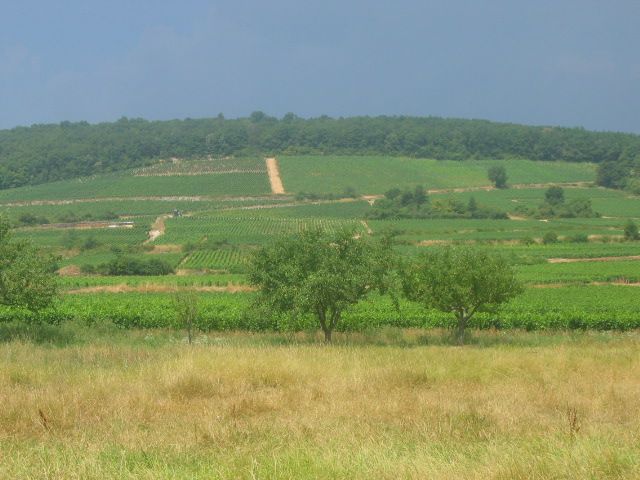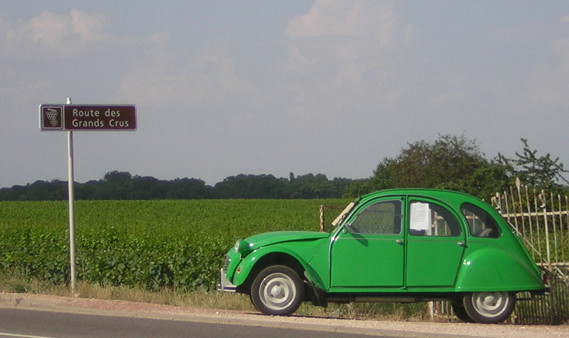Côte D'Or (escarpment) on:
[Wikipedia]
[Google]
[Amazon]

 The Côte d'Or () is a
The Côte d'Or () is a

thewinedoctor.com
A great overview of the geography and wines of Burgundy.
The Burgundy Report
Good descriptions of the vineyards and vintages. {{DEFAULTSORT:Cote d'Or (escarpment) Burgundy wine Landforms of Côte-d'Or Wine regions of France Escarpments of Europe

 The Côte d'Or () is a
The Côte d'Or () is a limestone
Limestone is a type of carbonate rock, carbonate sedimentary rock which is the main source of the material Lime (material), lime. It is composed mostly of the minerals calcite and aragonite, which are different Polymorphism (materials science) ...
escarpment
An escarpment is a steep slope or long cliff that forms as a result of faulting or erosion and separates two relatively level areas having different elevations.
Due to the similarity, the term '' scarp'' may mistakenly be incorrectly used inte ...
in Burgundy
Burgundy ( ; ; Burgundian: ''Bregogne'') is a historical territory and former administrative region and province of east-central France. The province was once home to the Dukes of Burgundy from the early 11th until the late 15th century. ...
, France, and the namesake of the department in which it is located. It stretches from Dijon
Dijon (, ; ; in Burgundian language (Oïl), Burgundian: ''Digion'') is a city in and the Prefectures in France, prefecture of the Côte-d'Or Departments of France, department and of the Bourgogne-Franche-Comté Regions of France, region in eas ...
in the north to the river Dheune to the south, overlooking the valley of the Saône
The Saône ( , ; ; ) is a river in eastern France (modern Regions of France, region of Bourgogne-Franche-Comté). It is a right tributary of the Rhône, rising at Vioménil in the Vosges (department), Vosges Departments of France, department an ...
to the east.
The east-facing slope of the Côte d'Or is home to Burgundy wine
Burgundy wine ( or ') is made in the Burgundy region of eastern France, in the valleys and slopes west of the Saône, a tributary of the Rhône. The most famous wines produced here, and those commonly referred to as "Burgundies", are dry (wine), ...
s such as Gevrey-Chambertin, Clos de Vougeot, Meursault and Montrachet. The northern half, the Côte de Nuits
The Côte de Nuits () is a French wine region located in the northern part of the Côte d'Or (escarpment), Côte d'Or, the limestone ridge that is at the heart of the Burgundy wine region. It extends from Dijon to just south of Nuits-Saint-Georges ...
, produces red wine almost exclusively. To the south, the Côte de Beaune produces a mix of white wine and red wine. The Route des Grands Crus (Route Nationale 74) runs along the foot of the ridge and is popular with tourists.
History
The area was settled by the Celts, and there is considerable evidence of Roman occupation in the area. Later it came under the influence of the Dukes of Burgundy, with the Cistercians from Cîteaux Abbey playing a prominent role in the development of the vineyards.Geology
If the Parishydrological
Hydrology () is the scientific study of the movement, distribution, and management of water on Earth and other planets, including the water cycle, water resources, and drainage basin sustainability. A practitioner of hydrology is called a hydro ...
and geological
Geology (). is a branch of natural science concerned with the Earth and other astronomical objects, the rocks of which they are composed, and the processes by which they change over time. Modern geology significantly overlaps all other Earth s ...
basin is viewed as a saucer with Paris at its centre, the Côte d'Or may be seen as a segment of its south-eastern rim; the counterpart of the chalk
Chalk is a soft, white, porous, sedimentary carbonate rock. It is a form of limestone composed of the mineral calcite and originally formed deep under the sea by the compression of microscopic plankton that had settled to the sea floor. Ch ...
cliffs of the Pays de Caux
The Pays de Caux (, , literally ''Land of Caux'') is an area in Normandy occupying the greater part of the French '' département'' of Seine Maritime in Normandy. It is a chalk plateau to the north of the Seine Estuary and extending to the cl ...
, on the English Channel
The English Channel, also known as the Channel, is an arm of the Atlantic Ocean that separates Southern England from northern France. It links to the southern part of the North Sea by the Strait of Dover at its northeastern end. It is the busi ...
coast to the north-west. The River Seine rises near the Côte d'Or and enters the sea near the Pays de Caux, having passed through Paris.
The Côte d'Or scarp arises where a broad, relatively shallow graben
In geology, a graben () is a depression (geology), depressed block of the Crust (geology), crust of a planet or moon, bordered by parallel normal faults.
Etymology
''Graben'' is a loan word from German language, German, meaning 'ditch' or 't ...
has formed as a result of an interaction between the forces raising the alpine ridges and the Massif Central. The Jurassic limestone
Limestone is a type of carbonate rock, carbonate sedimentary rock which is the main source of the material Lime (material), lime. It is composed mostly of the minerals calcite and aragonite, which are different Polymorphism (materials science) ...
contributes the chemically basic
Basic or BASIC may refer to:
Science and technology
* BASIC, a computer programming language
* Basic (chemistry), having the properties of a base
* Basic access authentication, in HTTP
Entertainment
* Basic (film), ''Basic'' (film), a 2003 film
...
component of the mixture of requirements for a good vineyard, while the scarp provides the drainage and aspect.
At the Côte d'Or, the middle and upper Jurassic
The Jurassic ( ) is a Geological period, geologic period and System (stratigraphy), stratigraphic system that spanned from the end of the Triassic Period million years ago (Mya) to the beginning of the Cretaceous Period, approximately 143.1 Mya. ...
rocks overlook the Oligocene
The Oligocene ( ) is a geologic epoch (geology), epoch of the Paleogene Geologic time scale, Period that extends from about 33.9 million to 23 million years before the present ( to ). As with other older geologic periods, the rock beds that defin ...
, Pliocene
The Pliocene ( ; also Pleiocene) is the epoch (geology), epoch in the geologic time scale that extends from 5.33 to 2.58Quaternary
The Quaternary ( ) is the current and most recent of the three periods of the Cenozoic Era in the geologic time scale of the International Commission on Stratigraphy (ICS), as well as the current and most recent of the twelve periods of the ...
rocks of the plain through which the Saône flows southward towards the Mediterranean Sea. The ''côte'' therefore forms part of the watershed between northern and southern Europe. On the far side of the plain rise the Jura Mountains
The Jura Mountains ( ) are a sub-alpine mountain range a short distance north of the Western Alps and mainly demarcate a long part of the French–Swiss border. While the Jura range proper (" folded Jura", ) is located in France and Switzerla ...
, for which the Jurassic period
The Jurassic ( ) is a geologic period and stratigraphic system that spanned from the end of the Triassic Period million years ago (Mya) to the beginning of the Cretaceous Period, approximately 143.1 Mya. The Jurassic constitutes the second and m ...
was named.

Comblanchien stone
NearNuits-Saint-Georges
Nuits-Saint-Georges () is a communes of France, commune in the arrondissement of Beaune of the Côte-d'Or Departments of France, department in the Bourgogne-Franche-Comté Regions of France, region in Eastern France.
Wine
Nuits-Saint-Georges is ...
, part of the middle Jurassic limestone has been metamorphosed into marble. The metamorphism seems to have arisen from the volcanic disturbances in the already existing ( Variscan) Massif Central, set off by the Alpine orogeny. The Massif Central is represented locally by its northern extension, the Morvan
The Morvan (; historically Morvand from the Latin ''Murvinnum'' 590)Pierre-Henri Billy, ''Dictionnaire des noms de lieux de la France'', éditions Errance, 640 pages, 2011 , is a mountainous massif lying just to the west of the Côte d'Or esc ...
, which lies between Nevers
Nevers ( , ; , later ''Nevirnum'' and ''Nebirnum'') is a city and the Prefectures in France, prefecture of the Nièvre Departments of France, department in the Bourgogne-Franche-Comté Regions of France, region in central France. It was the pr ...
and the Côte d'Or.
There is a famous vein of fine-grained marble called ''Pierre de Comblanchien'' extending from the village of Comblanchien, just south of Nuits-Saint-Georges. The quarries lie in the ''Côte'' north and south of the village, overlooking Route Nationale 74. The stone comes in a variety of shades, from beige to the pink of bindweed ( Convolvulus). It is not susceptible to frost damage and is capable of accepting a polish.
See also
*Burgundy wine
Burgundy wine ( or ') is made in the Burgundy region of eastern France, in the valleys and slopes west of the Saône, a tributary of the Rhône. The most famous wines produced here, and those commonly referred to as "Burgundies", are dry (wine), ...
* French wine
References
Further reading
* A bit out of date, and doesn't cover all of Burgundy, but is still the definitive guide. An updated version covering the whole region is due in early 2008. * Also in the process of being replaced, in two volumes - the book covering the outlying regions is due in late 2007, the Côte d'Or presumably in late 2008. * Foreword by Michael Broadbent, again a little out of date but good coverage of the top domaines. * Good inexpensive introduction to the region, and up to date. * An inexpensive introduction to the Côte d'Or and the most up to date.External links
thewinedoctor.com
A great overview of the geography and wines of Burgundy.
The Burgundy Report
Good descriptions of the vineyards and vintages. {{DEFAULTSORT:Cote d'Or (escarpment) Burgundy wine Landforms of Côte-d'Or Wine regions of France Escarpments of Europe